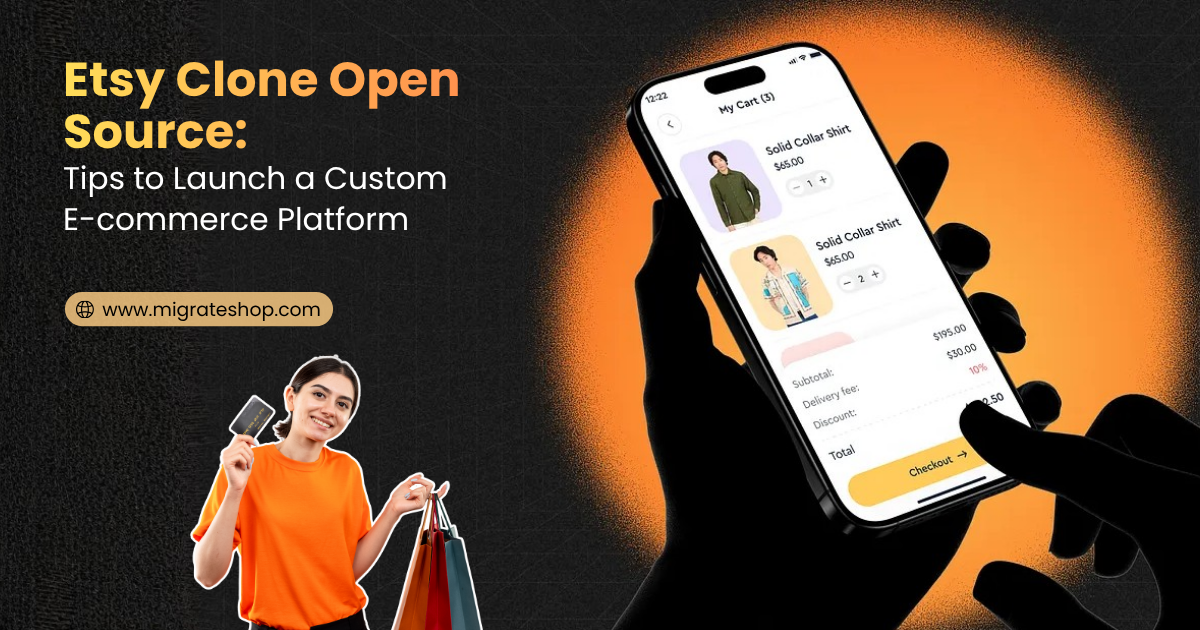In the modern digital world, e-commerce is a key to the success of a business, and websites such as Etsy have transformed the manner in which handmade, vintage, and unique items are accessed by a worldwide customer base. Etsy has become one of the first places a seller and a buyer can go; however, what happens when you want to make your own Etsy, one that fits your brand and requirements? It is where the Etsy Clone Open Source comes in.
An Etsy Clone Open Source business can provide an opportunity to the entrepreneur, who will have the chance to create an Etsy-type marketplace but with the possibility to adjust it to the needs of the business.
What is an Open Source Etsy Clone?
An open-source Etsy clone is a pre-written software platform that can provide the behavior of the Etsy online marketplace and can be customized freely and openly. The scripts help entrepreneurs to build their own multi-vendor e-business websites to sell handmade, vintage, or craft products easily and cheaply in place of developing a marketplace themselves. Its major features include a multi-vendor solution, product listing, and a custom design.
An online auction marketplace: It is a ready-made script that works in the same way as Etsy, with several sellers able to post items that buyers may buy.
Open-source: It means that the source code may be free of charge, i.e., it may be adapted and changed without incurring a high cost when a license is used.
Adaptive: The site can be customized, and it can be modified to suit business needs, branding, and product item categories.
Why Choose a Clone of Etsy Open Source?
An Etsy clone open source can be chosen based on the following reasons: it is a low-cost and quick option to build a multi-vendor marketplace that will offer both the buyer and seller a set of customizable functions.
This business model will enable investors to create a brand and community to work on instead of beginning the work all the way again, and the bonus is that the platform can be scaled and adjusted as time goes on.
Perks of an Etsy clone based on open source.
Economical: There is no licensing fee in open-source applications, and you can use the money to pay the hosting, customization, and marketing costs.
Determine your niche and audience: Determine who your target is, what they are willing to purchase, and what is not available in the existing market. The competitors and their prices gain a competitive advantage in the research.
Customization: It is an open-source script and can be altered to suit your requirements, be it that you wish to modify the design, add new features, or bring third-party applications.
Multi-vendor model: It is premised on the concept of creating a platform where a number of sellers will be enabled to create their own storefronts that will feature a wider range of items that can be bought by customers, not to mention that you can create a community of unique products.
Scalability: This platform can be scaled to meet your growing business requirements; hence, you can add more users, products, and transactions as your business marketplace continues to grow.
Security: Clone scripts normally have built-in security features of secure transactions and user authentication, which make the shopper have a more secure shopping experience.
Into Market: As the underlying technical infrastructure is now complete, you can spend your resources and time on user acquisition, expanding your vendor base, and developing marketing strategies.
User and Seller Empowerment: It also has the inbuilt means to empower the buyers and sellers, including product management tools, an easy storefront building tool for the sellers, good search and filter tools for the buyers, and community building.
Etsy Clone Open Source Core Features
All the key aspects of an Etsy clone open-source site, which include a multi-seller marketplace, the option to customize seller stores, a product listing and inventory system, a secure payment gateway, and efficient searching and filtering capabilities, are available.
Also, it must enable engagement with customers by facilitating reviews, ratings, and in-application messaging, as well as enabling administrative features to manage the users, products, and sales.
For sellers
Storefronts: Customized and branded personal shops per seller.
Product Management: Uploading, inventory management, and inventory tracking applications for unlimited products. It may include such aspects as bulk upload, custom options in products, and personalization fields.
Order Management: Intuitive tools to take care of and complete orders, tracking.
Communication: Direct in-app communication with the buyers.
For buyers
Search and Discovery: Advanced search, category, price, and style search, and so forth.
Shopping Experience: The shopping experience involves the wishlists, shopping carts, and the addition of items into the shopping cart.
Reviews and Ratings: It is a system that enables shoppers to leave remarks concerning goods and traders.
Community: Communities, such as the ability to join seller communities or discussion forums.
For Admins
Dashboard: This is a centralized administration system that is used to monitor and manage the marketplace.
User Management: Buyer and seller management tools.
Content Administration: Product, category, and other site content administration.
Payment and Commission: the development of payment gates and commissioning systems.
Analytics and Reporting: Support of analytics tools to track sales and user activity.
Promotional Tools: Inbuilt promotional, discount, and SEO capabilities.
Core Technical Features
Secure Payments: Support for several payment gateways to make secure payments.
Multi-Currency and Multi-Language: The international user base.
SEO Friendly: In-built search engine optimization tool.
API Integrations: APIs and connections to services and tools by a third party.
Process of Building and Launching your eCommerce Store
In order to open a custom e-commerce shop based on an Etsy clone open-source platform, consider a Minimum Viable Product (MVP) with basic functionality, value security, and a user-friendly interface, and design something that matches your brand. Following the first launch, including more sophisticated features as user feedback and the needs of the market allowed.
Market Research and Analysis
Identify your Niche and Audience: Find out who your target audience is, what they desire to buy, and any gaps in the current marketplace. A competitive advantage is achieved by competitors of the research and their prices.
Plan your Business Model: Develop a business model, including clear objectives, the way you plan to sell, and how you will commission, in case you are developing a marketplace.
Design a Minimum Viable Product (MVP): The initial launch does not need to be a complex one. Start with the least essential features like user registration, product listings, secure payments, and basic search features.
Select a Trustworthy Open-source Platform: Select an open source that is safe and provides all the customization you require.
Customizing your Platform
Emphasize the User Experience: Be easy, good-looking, and easy to use for both the sellers and the buyers.
Pay Attention to Safety: Introduce a high level of security for transactions and user information since this is one of the key points of establishing confidence.
Next-Gen Customized UI/UX: It can be made to look and feel like your unique brand.
Include Seller and Buyer Resources: Visibly offer tools to sellers to control listing, inventory, and orders. Provide customers with such capabilities as search filters, ratings, and reviews.
Combine Payment and Shipping: Establish safe payment gateways and transparent and trusted shipping and delivery.
Post Launch and Growth
Market your Store: Advertise your store on social media and other platforms to increase traffic.
Create an SEO Plan: Adopt search engine optimization in order to enhance visibility in search results.
Users’ Review: Take a Review of what the users think to include in the next release and where they feel something is not functioning well.
Build a Community: Add such community aspects as vendor profiles, social sharing, and buyer-seller messaging to make it more engaging.
Scale your Hosting: Scale your hosting services to allow you to upgrade your platform with the help of scalable hosting services in order to avoid over-investing in the early scaling stages.
Grow Capabilities: Add new, more sophisticated capabilities such as multi-language support, in-app chat, or loyalty programs with time, as the user base grows and in accordance with your business objectives.
Conclusion
Constructing your own e-business store based on an Etsy Clone Open Source solution can be both an incentive and a less expensive method of bringing up your online store. Using proper planning, design, and marketing strategy, you can develop a platform that sellers and buyers will want to be part of and have an easy user experience, and you can develop a successful online business. We are talking about handmade products, environmentally friendly products, or any other niche, and an Etsy Clone offers the freedom and the ability to scale that can take your idea to life.
With the tips shared herein, you will be on your path to establishing a stellar e-commerce site that will suit your needs and the needs of your community.
 Get upto 80% OFF
Get upto 80% OFF Financial Year End Sale!
Financial Year End Sale! 








